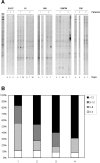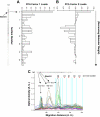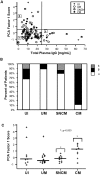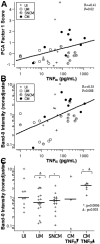Self-reactivities to the non-erythroid alpha spectrin correlate with cerebral malaria in Gabonese children
- PMID: 17460756
- PMCID: PMC1851099
- DOI: 10.1371/journal.pone.0000389
Self-reactivities to the non-erythroid alpha spectrin correlate with cerebral malaria in Gabonese children
Abstract
Background: Hypergammaglobulinemia and polyclonal B-cell activation commonly occur in Plasmodium sp. infections. Some of the antibodies produced recognize self-components and are correlated with disease severity in P. falciparum malaria. However, it is not known whether some self-reactive antibodies produced during P. falciparum infection contribute to the events leading to cerebral malaria (CM). We show here a correlation between self-antibody responses to a human brain protein and high levels of circulating TNF alpha (TNFalpha), with the manifestation of CM in Gabonese children.
Methodology: To study the role of self-reactive antibodies associated to the development of P. falciparum cerebral malaria, we used a combination of quantitative immunoblotting and multivariate analysis to analyse correlation between the reactivity of circulating IgG with a human brain protein extract and TNFalpha concentrations in cohorts of uninfected controls (UI) and P. falciparum-infected Gabonese children developing uncomplicated malaria (UM), severe non-cerebral malaria (SNCM), or CM.
Results/conclusion: The repertoire of brain antigens recognized by plasma IgGs was more diverse in infected than in UI individuals. Anti-brain reactivity was significantly higher in the CM group than in the UM and SNCM groups. IgG self-reactivity to brain antigens was also correlated with plasma IgG levels and age. We found that 90% of CM patients displayed reactivity to a high-molecular mass band containing the spectrin non-erythroid alpha chain. Reactivity with this band was correlated with high TNFalpha concentrations in CM patients. These results strongly suggest that an antibody response to brain antigens induced by P. falciparum infection may be associated with pathogenic mechanisms in patients developing CM.
Conflict of interest statement
Figures







References
-
- Breman JG, Egan A, Keusch GT. The intolerable burden of malaria: a new look at the numbers. Am J Trop Med Hyg. 2001;64:iv–vii. - PubMed
-
- Idro R, Jenkins NE, Newton CR. Pathogenesis, clinical features, and neurological outcome of cerebral malaria. Lancet Neurol. 2005;4:827–840. - PubMed
-
- Lang B, Newbold CI, Williams G, Peshu N, Marsh K, et al. Antibodies to voltage-gated calcium channels in children with falciparum malaria. J Infect Dis. 2005;191:117–121. - PubMed
-
- McKnight K, Jiang Y, Hart Y, Cavey A, Wroe S, et al. Serum antibodies in epilepsy and seizure-associated disorders. Neurology. 2005;65:1730–36. - PubMed
Publication types
MeSH terms
Substances
LinkOut - more resources
Full Text Sources
Other Literature Sources

